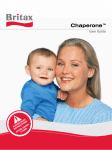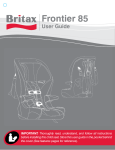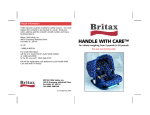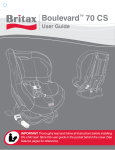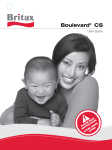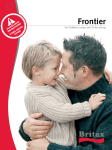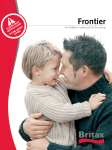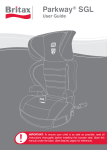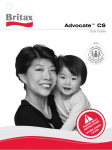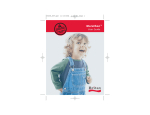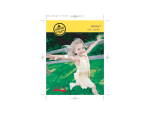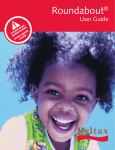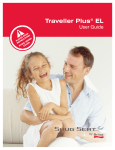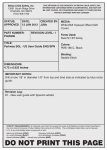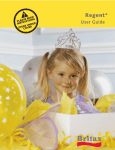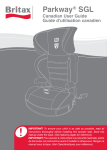Download "user manual"
Transcript
Chaperone™ User Guide AD RE NS SE TIO R A C E DE PL TRU UN S IN RE VER O ST CO Contents General Information.............................................................................................2 Registration.....................................................................................................................2 Service Life of Infant Carrier...........................................................................................2 Certification (Motor Vehicle and Aircraft)......................................................................3 General Warnings.................................................................................................4 Child Size: Height and Weight Limitations........................................................6 Vehicle Compatibility...........................................................................................7 Using LATCH..................................................................................................................7 Connecting the LATCH Connectors.............................................................................8 Locating and Storing the LATCH Connectors..............................................................9 Vehicle Seating Positions...............................................................................................10 Compatible Vehicle Seat Belts......................................................................................11 Incompatible Vehicle Seat Belts....................................................................................15 Infant Carrier Features................................................................................................. 16 Installing the Base................................................................................................18 LATCH Installation..........................................................................................................18 Lap-Shoulder Belt Installation........................................................................................24 Lap Belt Installation........................................................................................................28 Attaching Infant Carrier to Base....................................................................................32 Releasing Infant Carrier from Base...............................................................................33 Uninstalling the Base.....................................................................................................34 Lap-Shoulder Belt Installation........................................................................................36 Non-Locking Lap-Shoulder Belt Installation Using a Locking Clip.............................40 Lap Belt Installation........................................................................................................44 Removing the Infant Carrier...........................................................................................46 Adjusting the Harness....................................................................................................47 Harness Strap Adjustment.............................................................................................49 Adjusting the Buckle......................................................................................................50 Removing the Buckle.....................................................................................................50 Replacing the Buckle ....................................................................................................52 Low Birth Weight Infant Foam.......................................................................................53 Placing Child in Infant Carrier........................................................................................54 Installing Your Infant Carrier without Base........................................................36 Securing Your Child.............................................................................................47 General Usage......................................................................................................58 Care and Maintenance.........................................................................................60 Troubleshooting...................................................................................................71 Warranty................................................................................................................72 ©2009 Britax Child Safety, Inc. All rights reserved. P328900_R4.05.09 This product and its components are subject to change without notice. 2 General Information General Information 3 Registration Certification (Motor Vehicle and Aircraft) Fill out the registration card and mail it in today! Child restraints could be recalled for safety reasons. You must register this restraint to be reached in a recall. Send your name, address, e-mail address if available, and the restraint’s model number and manufacturing date to Britax Child Safety, Inc. P.O. Box 91167 Allentown, PA 18109-9925 or call 1-888-4BRITAX or register online at www.BritaxUSA.com/registration. For recall information, call the US Government’s Vehicle Safety Hot line at 1-888-327-4236 (TTY: 1-800424-9153) or go to http://www.NHTSA.gov. This child seat system conforms to all applicable Federal Motor Vehicle Safety Standards (FMVSS 213). This child seat is certified for use in motor vehicles and aircraft. Most airlines in the US and Canada will allow the use of a child seat as long as it is labeled as an approved child seat for airline use and fits properly on the aircraft seat. Contact the airline about their policy prior to traveling. The FAA recommends that a child weighing up to 40 pounds use a certified, harnessed child seat while traveling on an aircraft. Install your child seat in a window seat to avoid blocking the aisle. If the aircraft lap belt is too short, ask the flight attendant for a belt extender. For aircraft installation, see Lap Belt Installation instructions without base on Aircraft Installation pages 44 – 46. Serial Number:______________________ Model Number:_____________________ Batch Number:______________________ Date of Manufacture:_________________ Service Life of Infant Carrier To prevent injury due to deterioration or hidden damage, do not use an infant carrier and base that is older than six years or has been in a severe crash. See date of manufacture located on the infant carrier and base. IMPORTANT: • Do not use the base on aircraft. • Infant carrier handle must be in any locked position once installed. 4 General Warnings Warning: Death or Serious Injury Could Occur: • Use only in a rear-facing position when using it in the vehicle. • Use only with children who weigh between 4 and 30 pounds (1.8 and 13.6 kg) and whose height is 32 inches (81.3 cm) or less. • Snugly adjust the belts provided with this child restraint around your child. • Secure this child restraint with the vehicle’s child restraint anchorage system if available or with a vehicle belt. • Follow all instructions on this child restraint and in the written instructions located under the cover in the front of the child restraint. • Register your child restraint with the manufacturer. • Consult your child’s doctor before using this infant carrier. Some infants must be secured in a device that allows them to lie flat. • Never use the adjuster strap to lift or carry this infant carrier. Doing so could cause damage to the harness adjuster and webbing. Always carry a infant carrier by the handle or shell. • The primary protection for occupants of a vehicle in a collision is the structure of the vehicle; a infant carrier will not protect an infant when the vehicle is seriously impacted. However, correctly installed, an infant carrier will substantially improve the chances for survival in most crashes. Make sure that all users fully understand the correct ways to use this infant carrier in a vehicle. • This infant carrier must not be used in shopping carts, boats, or other non-certified applications. • NEVER leave child unattended. • The use of aftermarket covers, inserts, toys, accessories, or tightening devices is not approved by Britax. Their use could cause this infant carrier to fail Federal Safety Standards or not perform as intended in a crash. General Warnings 5 Warning: Death or Serious Injury Could Occur: • ALWAYS check the back seat upon leaving your vehicle to prevent leaving a child restrained in the infant carrier alone in the vehicle. • NEVER place the occupied infant carrier on beds, sofas, or other soft surfaces. Infant carrier can roll over on soft surfaces and suffocate the child. • NEVER place the occupied infant carrier near edges of counter tops, tables, or other elevated surfaces. Child’s movement can slide infant carrier. • ALWAYS use harness when child is in infant carrier. Never leave the occupied infant carrier when straps are loose or undone. A child can strangle in loose infant carrier straps. • NEVER use in or on strollers unless approved by Britax. • ALWAYS lift infant carrier by handle after installation in base to verify that it is secure. • DO NOT leave loose objects, e.g. books, bags, etc., in the back of a vehicle. In the event of a sudden stop, loose objects will keep moving, potentially causing serious injuries. • DO NOT leave folding vehicle seats unlatched. In the event of a sudden stop, a loose seat back could prevent the infant carrier from protecting the child as well as it should. • Cover the infant carrier when the vehicle is parked in direct sunlight. Parts of the infant carrier could become hot enough to burn the child. • DO NOT allow children to play with the infant carrier. Store the infant carrier in a safe place when it is not being used for an extended period of time. Do not place heavy objects on top of it. 6 Child Size: Height and Weight Limitations Vehicle Compatibility 7 Infant Carrier Capacities and Limitations Using LATCH According to the American Academy of Pediatrics: All infants should ride rear-facing until they have reached at least 1 year of age and weigh at least 20 pounds (9 kg). That means that if your infant reaches 20 pounds (9kg) before her first birthday, she should remain rear-facing at least until she turns 1 year old. It is best for children to ride rear-facing to the highest weight or height allowed by the manufacturer. Rear-Facing 2 1 in .5 c cm h Weight 4 pounds – 30 pounds (1.8 – 13.6 kg) Use rear-facing only with children: • who weigh between 4 and 30 lbs (1.8 – 13.6 kg) and • who are 32 inches in height (81.3 cm) or less a and Rear-Facing • whose top of the head is one inch or more below the top of the child seat shell and • when the harness straps are located at the harness height position at or below the child’s shoulders. WARNING! • Use either the LATCH system or the vehicle belt methods to install this child seat. Using both is not approved and may cause the child seat not to perform as intended. • Verify that your vehicle is equipped with LATCH anchors. If LATCH anchors are not available, you must use vehicle belt installation methods. • The LATCH connectors must be in an upright position and the strap should be tight and not twisted to ensure proper installation. Vehicles manufactured after September 1, 2002 have seating positions equipped with LATCH anchors. If a vehicle is equipped with LATCH, look for the LATCH or tether symbols identifying anchor locations. IMPORTANT: See Adjusting the Harness on page 47. WARNING! The child has outgrown the infant carrier when: • the child exceeds 30 lbs (13.6 kg) in weight or • the top of the head is less than one inch from top of the infant carrier or • height exceeds 32 inches (81.3 cm) The figure above shows typical locations for lower anchors and tether anchors in a vehicle. Check your vehicle owner’s manual for the exact anchor locations, and information on use with an infant carrier. 8 Vehicle Compatibility Only use the LATCH system on this infant carrier in a seating position designated by the vehicle owner’s manual. Refer to your vehicle owner’s manual or contact the vehicle manufacturer for the maximum weight rating for their LATCH anchors. This infant carrier was designed to be used with lower LATCH anchors in vehicle designated seating positions. The standard vehicle seat spacing between lower LATCH anchors is 11 inches (27.9 cm). This infant carrier can be used in a seating position with up to 20 inches (50.8 cm) of space between the LATCH anchors if the vehicle manufacturer allows. Vehicle Compatibility 9 Top Top NOTE: Ensure that the “top” of the LATCH connector is facing up when securing the base in your vehicle. Locating and Storing the LATCH Connectors The LATCH connectors are located on the sides of the base inside the LATCH connector storage slots. Store the LATCH connectors when not in use. To remove the LATCH connectors from the storage slots: Up to 20 inches (50.8 cm) Check your vehicle owner’s manual for information on using child restraints in center seating positions without designated LATCH anchors. Connecting the LATCH Connectors The LATCH connectors must be properly aligned with the vehicle LATCH anchors to ensure a proper and secure connection. Always check that the LATCH connector strap is not twisted and that the LATCH connector is correctly aligned before connecting to the vehicle LATCH anchor. 1 Press and hold the red release button. 2 Pull the LATCH connector from the storage slot. To store the LATCH connectors: Push the LATCH connector into the storage slot until a click is heard to store the LATCH connectors. NOTE: The LATCH connectors are stored with the “top” facing down as shown. Top 10 Vehicle Compatibility Vehicle Seating Positions WARNING! Based on crash statistics, the National Highway Traffic Safety Administration (NHTSA) recommends that parents select the back seat as the safest location for a properly installed infant carrier. DO NOT place a rear-facing child seat on the front seat with an air bag. DEATH or SERIOUS INJURY can occur. See your vehicle owner’s manual for infant carrier installation instructions. The back seat is the safest place for children 12 and under. This infant carrier must only be used in forward-facing vehicle seats. Side-facing or rear-facing seats CANNOT be used. If in doubt about installing the infant carrier, consult the vehicle owner’s manual. Some vehicles have no seating positions which are compatible with this infant carrier or any other infant carrier. If in doubt, contact the vehicle manufacturer for assistance. See diagram below. Vehicle Compatibility 11 Compatible Vehicle Seat Belts NOTE: The information in this section only applies to installation with vehicle safety belts. Vehicle seat belts compatible with this child seat are: Lap-shoulder belts and Lap only belts equipped with a switchable retractor, or an automatic locking retractor (ALR), or a locking latch plate. Vehicle seats and safety belts differ from vehicle to vehicle. Your vehicle owner’s manual will have information on the types of vehicle belts in your vehicle. Refer to your vehicle owner’s manual for specific information about vehicle safety belts and their use with child seats. Lap-Shoulder (3 Point) Belt Switchable Retractor in ALR (Automatic Locking Retractor) Mode with Sliding Latch Plate 1 Has a latch plate that freely slides along the vehicle belt webbing. 2 Has a retractor that can be switched so that it always locks (Automatic Locking Retractor-ALR) or so it only locks during sudden stops or crashes (Emergency Locking Retractor-ELR). * To use this infant carrier with this type of vehicle belt, you must switch to the ALR mode or use child seat lock-offs with base or a locking clip with carrier only. NOTE: Refer to your vehicle owner’s manual to determine the kind of retractors used in your vehicle and how to operate them. 12 Vehicle Compatibility ALR (Automatic Locking Retractor) with Sliding Latch Plate 1 Has a latch plate that freely slides along the vehicle belt webbing. 2 Has a retractor that stops the belt from being pulled out again once it has been pulled out. * The ALR in some vehicle belts may not activate unless the belt is pulled out at least 24 inches (61 cm). 3 Tightens by feeding the belt webbing back into the retractor. Vehicle Compatibility 13 2 Has a retractor that locks only in an emergency situation such as sudden stop or crash. ELR (Emergency Locking Retractor ) with a Sliding Latch Plate 1 Has a latch plate that freely slides along the vehicle belt webbing, and 2 Has a retractor that locks only in an emergency situation such as sudden stop or crash. This type of retractor is commonly referred to as an Emergency Locking Retractor or ELR. This belt type requires the use of the lock-off built into the base. ELR (Emergency Locking Retractor) with Locking Latch Plate 1 Has a latch plate that does not allow the lap part of the belt to become loose after it is buckled. NOTE: The base for this infant carrier is equipped with a lock-off. If installing the carrier without the base, a locking clip must be used with a non-locking lap-shoulder belt. Call Britax Consumer Services at 1.888.427.4829 to purchase a locking clip. Locking Clip 14 Vehicle Compatibility Lap Belt ALR (Automatic Locking Retractor) 1 Has a latch plate that is sewn onto the webbing. Vehicle Compatibility 15 Incompatible Vehicle Seat Belts WARNING! The following types of vehicle belts are NOT compatible with this child seat: 2 Has a retractor that stops the belt from being pulled out again once it has been pulled out. * The ALR in some vehicle belts may not activate unless the belt is pulled out at least 24 inches (61 cm). 3 Tightens by feeding the belt webbing back into the retractor. Locking Latch Plate 1 Has a latch plate that does not allow the belt to become loose after it is buckled. 2 Tightens by pulling on the belt webbing after it is buckled. NOTE: Not all locking latch plates look and operate in the same manner. Refer to your vehicle owner’s manual to determine the kind of seat belts used in your vehicle and how to operate them with child seats. 1 Vehicle belts with top or bottom anchor points on the vehicle door. 2 Motorized, automatic vehicle belts 3 Lap-shoulder belts that have a separate retractor each for the lap section and shoulder section. 4 Lap belts forward of the seat bight 5 Lap belts that have a retractor that locks only in case of a sudden stop (emergency locking retractor- or ELR). 16 2 1 3 4 5 6 7 8 2 1 9 15 14 14 1 2 3 4 5 6 7 8 9 10 Canopy Head Restraint Harness Slots 13 Comfort Pads Chest Clip Harness Straps Buckle Belly Pad Carrier Belt Guides Harness Adjuster Lever (under button hole slot) 11 User guide (stored under cover) 12 Harness Adjuster Strap 27 17 16 Infant Carrier Features 10 11 13 13 14 15 16 17 18 19 20 21 22 23 24 12 Low Birth Weight Infant Foam Handle Recline Angle Level Indicator Infant Carrier Release Handle Harness Adjuster Serial Number and Date of Manufacture label Harness Yoke Base Belt Guides LATCH Adjuster Release Button LATCH Adjuster LATCH Connector Storage Slot LATCH Connector 3 4 5 6 7 8 16 17 Infant Carrier Features 17 6 27 18 19 31 6 20 18 19 30 29 28 9 10 11 27 20 12 20 21 22 23 21 22 23 27 26 24 25 26 24 25 25 LATCH Connector Release Button 26 Recline Adjustment Foot 27 Anti-Rebound Bar 28 Carrier Attachment Clips 29 Serial Number and Date of Manufacture label (on bottom of base) 30 Lock-off 31 Recline Adjustment Knob IMPORTANT: When not in use, this user guide should be stored under the cover. 31 20 30 29 28 18 Installing the Base Installing the Base 19 LATCH Installation WARNING! • Only raise the base as described in these instructions. Do not use anything to raise the base of the infant carrier off of the front edge of the vehicle seat. In a crash, this could cause the infant carrier not to perform as intended. • The base must ALWAYS be secured in a vehicle as described on pages 18 – 31 before attaching the occupied infant carrier to the base. Never attach the occupied infant carrier to the base unless the base is properly secured in a vehicle. • Use either the LATCH system or the vehicle belt methods to install this child seat. Using both is not approved and may cause the child seat not to perform as intended. Before You Begin: 3 Press and hold the red release button on the LATCH connector while removing the LATCH connectors from the storage slots. 4 Position the base in the desired vehicle seating position equipped with LATCH. 5 Attach each LATCH connector to the adjacent vehicle LATCH anchor by pushing them firmly onto the vehicle LATCH anchors until a click is heard. 6 Pull on the LATCH connectors to verify that the connection is secure. 99Remove the infant carrier before installing the base, if attached. 99Verify that your vehicle is equipped with LATCH anchors. * If you car does not have LATCH anchors, you must use vehicle belt installation methods. Base Installation with LATCH 1 Open the lock-off by lifting the tabs, and then lifting the lockoff plate. 2 Press the LATCH adjuster release button while pulling the LATCH strap to loosen the LATCH connector strap. * Verify that the LATCH connector straps are not twisted. 20 Installing the Base Installing the Base 21 12Verify that all connections are secure. Check that: 99The LATCH strap is not twisted. 99The LATCH connectors are properly aligned. 99The excess LATCH webbing has been secured in the lock-off. 99The infant carrier handle is rotated into any locked position. 99The infant carrier is secure. 7 Push the base firmly into the vehicle seat and then pull the LATCH adjuster strap to tighten. 8 Route any loose webbing from the LATCH adjuster through the lock-off. 9 Close the lock-off plate over the webbing. 10Press firmly on the lock-off plate, and then close both lock-off tabs. 11Place the infant carrier into the base and press down until a click is heard. * Pull up on the carrier handle to confirm attachment. * If the base and infant carrier can be moved more than 1 in. (2.5 cm) front-to-back or side-to-side at the LATCH strap path, repeat installation or choose another seating location. 13Check the recline angle. 14The proper recline angle is achieved when the level indicators on the infant carrier are within the level lines. IMPORTANT: If a correction is required, do not turn the recline adjustment knob until tension has been removed from the LATCH strap. NOTE: It may be necessary to install and uninstall the base more than once to achieve the proper recline angle. The vehicle should be parked on a level surface. 22 Installing the Base Installing the Base 23 Follow the steps below if adjustment of the recline angle is necessary: If there is a problem achieving the proper recline angle after following the previous steps: f Uninstall the base and rotate the recline adjuster on the base to the lowest position. g Remove the base from the vehicle seat. a Press the LATCH adjuster release button to release tension in the LATCH strap. b Press the LATCH connector release button and detach the LATCH connectors from the LATCH anchors. h Place a rolled towel or pool noodle in the vehicle seat bight. c Turn the recline adjustment knob d Connect and tighten the LATCH to adjust the recline angle. strap. e Place the infant carrier in the base and check the recline angle. Repeat the previous steps until a secure fit with proper recline angle is achieved.Continue with installation instructions from step 7 on page 20. i Place the base on the towel or pool noodle to help level the base and continue installation from step 7 on page 20. 24 Installing the Base Installing the Base 25 Lap-Shoulder Belt Installation Before You Begin: 99Remove the infant carrier before installing the base, if attached. 99Ensure that the LATCH connectors are in the storage slots in the base. 99Check that your vehicle seat belt is compatible with infant carrier use. See pages 11 – 15 for more Base Installation with Lap-Shoulder information. belt 1 Position the base in the desired vehicle seating position. 2 Open the lock-off by lifting the tabs, and then lifting the lockoff plate. 5 Push the base firmly into the vehicle seat and remove all slack from the lap portion of the vehicle belt. 6 Pull the shoulder part of the vehicle belt tight and then route under both belt guides. 7 Hold the shoulder belt tight and close the lock-off plate over the vehicle belt. 8 Press firmly on the lock-off plate, and then close both lock-off tabs. 9 Place the infant carrier into the base and press down until a click is heard. * Pull up on the carrier handle to confirm attachment. 3 Pull the vehicle belt out and route the lap portion under both belt guides. 4 Verify that the vehicle belt is not twisted and then buckle. 26 Installing the Base Installing the Base 27 10Verify that the vehicle belt is tight and that the base is secure. The base is secure when it moves less than 1 inch (2.5 cm) front to back or side to side at the vehicle belt path. 11Verify that all connections are secure. Check that: 99The vehicle belt is not twisted. 99The vehicle belt is tight and locked. Follow the steps below if adjustment of the recline angle is necessary: a Unbuckle the seat belt. b Turn the recline adjustment knob on to adjust the recline angle. * Check that the vehicle belt has been properly routed through the lock-off and that the lock-off is closed tightly. 99The infant carrier handle is rotated into any locked position. 99The infant carrier is secure. * If the base and infant carrier can be moved more than 1 in. (2.5 cm) front-to-back or side-to-side at the vehicle belt path, repeat installation or choose another seating location. c Place the infant carrier in the base and check the recline angle. Repeat the previous steps until a secure installation with proper recline angle is achieved. Continue with installation instructions from step 3. If there is a problem achieving the proper recline angle after following the previous steps: d Uninstall the base and rotate the recline adjuster on the base to the lowest position. e Remove the base from the vehicle seat. 12Check the recline angle. 13The proper recline angle is achieved when the level indicators on the infant carrier are within the level lines. NOTE: It may be necessary to install and uninstall the base more than once to achieve the proper recline angle. The vehicle should be parked on a level surface. f Place a rolled towel or pool noodle in the crease of the vehicle seat. g Place the base on the towel or pool noodle to help level the base and continue installation from step 3 on page 24. 28 Installing the Base Installing the Base 29 Lap Belt Installation Before You Begin: 99Remove the infant carrier before installing the base, if attached. 99Ensure that the LATCH connectors are in the storage slots in the base. 99Check that your vehicle seat belt is compatible with infant carrier use. See pages 11 – 15 for more Base Installation with Lap Belt information. 1 Position the base in the desired vehicle seating position. 2 Open the lock-off by pressing down on the lock-off plate, lifting the tabs, and then lifting the lock-off plate. 5 Push the base firmly into the vehicle seat while removing all slack from the vehicle belt. 7 Close the lock-off plate over the webbing and close both lock-off tabs while pressing firmly on the lock-off plate. * The lock-off is properly secured when the tabs lay flat against the lock-off plate. * If the lock-off will not close, remove the excess vehicle belt webbing and tuck it under the base. 3 Pull the vehicle belt out and route under both belt guides. 4 Verify that the vehicle belt is not twisted and then buckle. 6 Route any excess webbing from the vehicle belt through the lock-off. 8 Place the infant carrier into the base and press down until a click is heard. * Pull up on the carrier handle to confirm attachment. 9 Verify that the vehicle belt is tight and that the base is secure. The base is secure when it moves less than 1 inch (2.5 cm) front to back or side to side at the vehicle belt path. 30 Installing the Base Installing the Base 31 10Verify that all connections are secure. Check that: 99The vehicle belt is not twisted. 99The vehicle belt is tight and locked. * Check that the vehicle belt retractor is locked or, * Check that the vehicle belt has been properly routed through the lock-off and that the lock-off is closed tightly. Follow the steps below if adjustment of the recline angle is necessary: a Unbuckle the seat belt. b Turn the recline adjustment knob on to adjust the recline angle. 99The infant carrier handle is rotated into any locked position. 99The infant carrier is secure. * If the base and infant carrier can be moved more than 1 in. (2.5 cm) front-to-back or side-to-side at the vehicle belt path, repeat installation or choose another seating location. c Place the infant carrier in the base and check the recline angle. Repeat the previous steps until a secure installation with proper recline angle is achieved. Continue with installation instructions from step 3. If there is a problem achieving the proper recline angle after following the previous steps: d Uninstall the base and rotate the recline adjuster on the base to the lowest position. e Remove the base from the vehicle seat. 11Check the recline angle. 12The proper recline angle is achieved when the level indicators on the infant carrier are within the level lines. NOTE: It may be necessary to install and uninstall the base more than once to achieve the proper recline angle. The vehicle should be parked on a level surface. f Place a rolled towel or pool noodle in the crease of the vehicle seat. g Place the base on the towel or pool noodle to help level the base and continue installation from step 3 on page 28. 32 Installing the Base Installing the Base 33 Attaching Infant Carrier to Base Releasing Infant Carrier from Base 1 Align the infant carrier with the slots in the base, ensuring that the infant carrier faces the rear of the vehicle. 2 Set the infant carrier into base until an audible click is heard. 1 If necessary, rotate the handle into the carrying position. 2 Locate the release handle at the rear of the infant carrier. 3 Pull up on the infant carrier handle to ensure it is properly secured. 4 Rotate the handle to any locked position. 3 Squeeze and hold the release handle. 4 Lift the infant carrier away from the base. 34 Uninstalling the Base Uninstalling the Base 35 Removal of Base Removal of Base LATCH Installation: Vehicle Belt Installation: IMPORTANT: Always remove the infant carrier before attempting to remove the base. IMPORTANT: Always remove the infant carrier before attempting to remove the base. 1 Open the lock-off by lifting the tabs, and then lifting the lockoff plate. 1 Open the lock-off by lifting the tabs, and then lifting the lockoff plate. 3 Press the LATCH connector release button on each connector to detach them from the LATCH anchors. 4 Remove the base from the vehicle. 2 Press the LATCH adjuster release button to release tension in the LATCH strap. 3 Pull the vehicle belt from the base belt guides. 4 Remove the base from the vehicle. 2 Press the release button on the vehicle belt buckle. 36 Installing Your Infant Carrier without Base Installing Your Infant Carrier without Base 37 Installation without Base Lap-Shoulder Belt Installation Before You Begin: 99Check that your vehicle seat belt is compatible with infant carrier use. See pages 11 – 15 for more information. 99Check your vehicle owner’s manual to determine how to lock your vehicle belt system. 99Secure child in carrier before installing carrier in vehicle. Carrier Installation with Lap Shoulder Belt 3 Route the lap part of the vehicle belt through the second belt guide. * Do not route the shoulder portion of the vehicle belt through the belt guides. 4 Verify that the vehicle belt is not twisted and then buckle. 5 Lock your vehicle seat belt system as instructed by your vehicle owner’s manual. * See pages 11 – 15 for more information. 6 Push the infant carrier firmly into the vehicle seat while removing all slack from the lap portion and then the shoulder portion of the vehicle belt. 1 Place the infant carrier rearfacing on the vehicle seat. 2 Pull the vehicle belt out and route the lap portion of the vehicle belt through the first belt guide. * Do not route the shoulder portion of the vehicle belt through the belt guides. IMPORTANT: If you cannot lock your vehicle seat belt you must use a locking clip. See pages 40 – 43. Locking clips are available for purchase by contacting Britax Consumer Services at 1.888.427.4829. 38 Installing Your Infant Carrier without Base 7 Adjust the infant carrier handle to any locked position. Installing Your Infant Carrier without Base 39 Follow the steps below if adjustment of the recline angle is necessary: a Unbuckle the seat belt. 8 Verify that all connections are secure. Check that: 99The vehicle belt is not twisted. 99The vehicle belt is tight and locked. * Check that the vehicle belt retractor is locked or, * Check that the latch plate is locked or, * Ensure that a locking clip has been properly installed. 99The infant carrier handle is rotated into any locked position. 99The infant carrier is secure. * If the infant carrier can be moved more than 1 in. (2.5 cm) front-to-back or side-to-side at the vehicle belt path, repeat installation or choose another seating location. b Place a rolled towel or pool noodle in the vehicle seat bight. * See note below. c Place the infant carrier on the towel or pool noodle to help level the base. Repeat the previous steps until a secure installation with proper recline angle is achieved. Continue with installation instructions from step 2 on page 36. NOTE: Configure pool noodle(s) to accommodate variations in vehicle seat contour as necessary. 9 Check the recline angle. 10The proper recline angle is achieved when the level indicators on the infant carrier are within the level lines. NOTE: It may be necessary to install and uninstall the infant carrier more than once to achieve the proper recline angle. The vehicle should be parked on a level surface. 40 Installing Your Infant Carrier without Base Installing Your Infant Carrier without Base 41 Non-Locking Lap-Shoulder Belt Installation Using a Locking Clip IMPORTANT: When installing this restraint using a non-locking vehicle belt, a locking clip must be used. Refer to your vehicle owner’s manual for instructions on correct use of vehicle belts with child seats. Before You Begin: 99Ensure you have a locking clip. Locking clips are available for purchase by contacting Britax Consumer Services at 1.888.427.4829. 3 Route the lap part of the vehicle belt through the second belt guide. * Do not route the shoulder portion of the vehicle belt through the belt guides. 4 Verify that the vehicle belt is not twisted and then buckle. 99Secure child in carrier before installing carrier in vehicle Carrier Installation with a NonLocking Lap-Shoulder Belt 5 Push the infant carrier firmly into the vehicle seat while removing all slack from the lap portion, and then the shoulder portion of the vehicle belt. 7 Thread the locking clip onto both 1 Place the infant carrier rear-facing on the vehicle seat. 2 Pull the vehicle belt out and route the lap portion of the vehicle belt through the first belt guide. * Do not route the shoulder portion of the vehicle belt through the belt guides. belts, placing it within 1 inch of the latch plate. 6 Hold the lap and shoulder belts together behind the latch plate and unbuckle. 42 Installing Your Infant Carrier without Base Installing Your Infant Carrier without Base 43 12The proper recline angle is achieved when the level indicators on the infant carrier are within the level lines. 8 Buckle the vehicle belt. * The vehicle belt should be tight around the infant carrier. If it is not tight, unbuckle the belt, remove the locking clip, and repeat steps 2 – 7. 9 Adjust the infant carrier handle to any locked position. 10Verify that all connections are secure. Check that: 99The vehicle belt is not twisted. 99The vehicle belt is tight and locked. NOTE: It may be necessary to install and uninstall the infant carrier more than once to achieve the proper recline angle. The vehicle should be parked on a level surface. Follow the steps below if adjustment of the recline angle is necessary: a Unbuckle the seat belt. * Ensure that a locking clip has been properly installed. 99The infant carrier handle is rotated into any locked position. 99The infant carrier is secure. * If the infant carrier can be moved more than 1 in. (2.5 cm) front-to-back or side-to-side at the vehicle belt path, repeat installation or choose another seating location. 11Check the recline angle. b Place a rolled towel or pool noodle in the vehicle seat bight. * See note below. c Place the infant carrier on the towel or pool noodle to help level the base. Repeat the previous steps until a secure installation with proper recline angle is achieved. Continue with installation instructions from step 2 on page 40. NOTE: Configure pool noodle(s) to accommodate variations in vehicle seat contour as necessary. 44 Installing Your Infant Carrier without Base Installing Your Infant Carrier without Base 45 5 Adjust the infant carrier handle to any locked position. Lap Belt Installation Before You Begin 99 Check your vehicle owner’s manual to see if your seat belt is compatible with infant carrier use. See pages 11 – 15 for more information. 99 There are many different types of lap belts. Check your vehicle owner’s manual to determine how to lock your vehicle belt system. 99 Secure child in carrier before installing Carrier Installation with Lap Belt carrier in vehicle. 6 Verify that all connections are secure. Check that: 99The vehicle belt is not twisted. 99The vehicle belt is tight and locked. * There are many different types of lap belts. Check your vehicle owner’s manual for installation instructions with child restraints. 99The recline level indicator is within the level lines. 99The infant carrier handle is rotated into any locked position. 99The infant carrier is stable. * If the infant carrier can be moved more than 1 in. (2.5 cm) front-to-back or side-to-side at the vehicle belt path, repeat installation or choose another seating location. 1 Place the infant carrier rearfacing on the vehicle seat. 2 Pull the vehicle belt out and route the vehicle belt under both belt guides. 7 Check the recline angle. 3 Verify that the vehicle belt is not twisted and then buckle. 4 Push the infant carrier firmly into the vehicle seat while removing all slack from the vehicle belt. 8 The proper recline angle is achieved when the level indicators on the infant carrier are within the level lines. NOTE: It may be necessary to install and uninstall the infant carrier more than once to achieve the proper recline angle. The vehicle should be parked on a level surface 46 Installing Your Infant Carrier without Base Follow the steps below if adjustment of the recline angle is necessary: a Unbuckle the seat belt. b Place a rolled towel or pool noodle in the vehicle seat bight. * See note below. c Place the infant carrier on the towel or pool noodle to help level the base. Repeat the previous steps until a secure installation with proper recline angle is achieved. Continue with installation instructions from step 2 on page 44. NOTE: Configure pool noodle(s) to accommodate variations in vehicle seat contour as necessary. Securing Your Child 47 Securing Your Child in the Infant Carrier WARNING! • Adjust harness to fit clothes the child is wearing. Remove bulky coats and/or jackets before putting child in infant carrier. • Adjust the belts provided with this child seat so they fit snugly around your child. A snug strap should not allow any slack. It lies in a relatively straight line without sagging. It does not press on the child’s flesh or push the child’s body into an unnatural position. • Verify that the infant carrier is secure and that the harness is properly adjusted around the child EACH time the infant carrier is used. Failure to properly adjust the harness could result in death or serious injury. Adjusting the Harness The harness should be properly adjusted to fit your child prior to installing the infant carrier in your vehicle. Follow the steps below to prepare the infant carrier harness for use with your child. Removing the Infant Carrier Press 1 Unbuckle the vehicle belt. 2 Pull the vehicle belt from the infant carrier belt guides. IMPORTANT: If you have installed the infant carrier using a locking clip, ensure that the locking clip is removed before the vehicle belt is used by a passenger not riding in a child restraint. Pull 1 Unbuckle the harness by pressing the red release button and pulling the buckle tongues from the buckle. 2 Release the chest clip, by pressing the release button and pulling apart the two halves. 48 Securing Your Child Securing Your Child 49 Rear-Facing Strap Height 3 Move the harness straps to the side of the infant carrier. 4 Move the buckle away from the seating area of the infant carrier. 5 Place the child in the infant carrier and check the harness height. * The correct height for the harness straps is at or below the child’s shoulders. Harness Strap Adjustment When using the inner buckle strap slot for a child 11 lbs (5 kg) or below, the inner harness strap loops must be used. When using the outer buckle strap slot for a child above 11 lbs (5 kg), the end loops of the harness strap must be used. See page 50. Depending on the size of your child, you will need to adjust the shoulder straps on the harness to ensure the harness provides the most snug fit around your child. A snug strap should not allow any slack. It lies in a relatively straight line without sagging. It does not press on the child’s flesh or push the child’s body into an unnatural position. To Adjust the Shoulder Straps of the Harness: If the harness straps need height adjustment follow the steps below: a Lift the harness height adjuster on the back of the infant carrier. b Slide the harness height adjuster up or down into the nearest position at or below your child’s shoulders. c The harness height adjuster will lock into place once released. NOTE: The head restraint and harness strap adjustment is controlled by the harness height adjuster on the back of the infant carrier shell. The head restraint will be at the correct height adjustment once the harness straps are correctly positioned for your child. 1 Locate the harness yoke on the back of the infant carrier shell. 3 Select the appropriate loop on the harness strap for the size of your infant. * Use the bottom loops for infants 11 lbs (5 kg) and under, and the end loops for infants 11 lbs (5 kg) and over. * DO NOT use the middle section between the end and bottom loops. 4 Slide the harness strap onto the harness yoke. 2 Slide the harness straps from the harness yoke. End Loops Bottom Loops 50 Securing Your Child Securing Your Child 51 IMPORTANT: Harness straps must hang as shown by above. Do not tuck the straps behind the harness yoke. Pull on the harness straps to ensure the harness strap webbing is secured within the slots of the harness yoke. 4 Locate the buckle strap retainer 5 Pull the buckle strap retainer away 6 Turn the buckle strap retainer so 7 Thread the buckle strap retainer attached to the opposite end of the buckle strap on the bottom of the infant carrier shell. from the infant carrier to loosen. Adjusting the Buckle IMPORTANT: Your infant carrier has been assembled with the buckle strap in the inner position for infants weighing less than 11 lbs (5 kg). Once your child reaches 11 lbs (5 kg) re-route the buckle position to the outer position. Follow the steps below to adjust the buckle position. See page 49 for important information for adjusting the harness straps for the fit of your child. Removing the Buckle 1 Remove the infant carrier from the base if attached. that the short side will go through the slot in the infant carrier shell and cover. 2 Pull the plastic flaps on the cover from the infant carrier shell. 3 Pull the infant carrier cover and foam back to access the buckle slots. through the slot in the infant carrier shell and cover. 52 Securing Your Child Securing Your Child 53 Low Birth Weight Infant Foam Replacing the Buckle Low birth weight foam has been included with this infant carrier for infants weighing 4 to 11 lbs (1.81 – 5 kg). This foam may be necessary for low birth weight infants to achieve a snug fit of the harness around your child. Also see page 6. IMPORTANT: Do not use low birth weight foam for infants weighing more than 11 lbs (5 kg). Always use inner buckle strap slot when using low birth weight infant foam see pages 49 – 50. To use the Low Birth Weight Infant Foam: 1 Turn the buckle strap retainer so that the short side will go through the slot in the cover and infant carrier shell. 2 Thread the buckle strap retainer through the desired slot in the infant carrier shell and cover to the bottom of the infant carrier shell. 1 Pull the plastic flaps on the cover 2 Pull the infant carrier cover and foam 3 Slide the foam into place around 4 If the buckle was removed, thread from the infant carrier shell. 3 Pull the buckle away from the infant carrier to ensure the buckle strap retainer lies flat against the infant carrier shell. 4 Check that the buckle strap is not twisted and that the red release button faces out. the buckle slots. * The buckle can be removed as described on pages 50 – 51 for easier placement of the foam. back to access the buckle slots. the buckle retainer through the slot in the foam insert, foam pad, and infant carrier shell. * Ensure the buckle retainer lies flat against the infant carrier shell. 5 Replace the cover. 54 Securing Your Child Securing Your Child 55 Placing Child in Infant Carrier Slouching Sitting Up 1 Loosen the harness by pressing the harness adjuster lever while pulling both harness straps forward. 2 Press the tab and pull apart the two halves to release the chest clip. 3 Unbuckle the harness by pressing the red release button on the buckle and pulling the tongues from the buckle. 4 Move the harness straps to the sides of the infant carrier. 5 Place the child in the infant carrier as shown. 6 Position the harness straps around the child. 7 Buckle the harness by inserting one buckle tongue at a time into the harness buckle. 8 Fasten the chest clip by sliding the two halves of the chest clip together until a click is heard. * Connection is confirmed with an audible click after inserting each buckle tongue. * Always pull on the buckle to ensure the buckle is properly connected. 56 Securing Your Child Securing Your Child 57 11Position the chest clip at the center of the child’s chest, level with the child’s armpits. 9 Gently pull up on the harness straps to tighten the lap section of the harness, which should fit low on the child’s body. 10Slowly pull the adjuster strap to tighten the harness around the child. NOTE: Snugly adjust the belts provided with this child restraint around your child. A snug strap should not allow any slack. It lies in a relatively straight line without sagging. It does not press on the child’s flesh or push the child’s body into an unnatural position. Pull the harness adjuster away from the child seat (parallel to the ground) to tighten. Do not pull at a sideways angle. 12Verify that the harness is not twisted and the child is properly secured. Check that the: 99Buckle is fastened 99Harness straps are not twisted. 99Harness is snug 99Chest clip is at the child’s armpit level. IMPORTANT: • Always pull on the harness after securing the child to make sure the buckle and harness are locked. If not, the buckle or adjuster area may be clogged with food, drink, or objects that need to be removed. See pages 68 – 70 for cleaning instructions. • Always make sure that the harness is tight before each use, or after any adjustments. 58 General Usage General Usage 59 Handle Positions User Guide Storage The carrier handle must be adjusted to one of the three locked positions. To adjust, press and hold both handle release levers and rotate the handle into one of the three locked positions. Tuck the user guide and lanyard under the cover in the front of the infant carrier to store. Seat Storage Store the infant carrier in a safe, dry place when it is not being used for an extended period of time. Do not place heavy objects on top of it. Cover the infant carrier to help keep it clean. Remove and wash the cover and canopy (see instructions on pages 60 – 65) before using the seat the first time after storage. Canopy Transporting an Unoccupied Infant Carrier Attach this infant carrier to a securely installed base or install the infant carrier with a vehicle seat belt without the base even when it is not occupied. In a crash, an unsecured infant carrier may injure vehicle occupants in your vehicle before transport. See pages 18 – 46 for installation instructions. 1 To raise the canopy, pull the canopy fabric at the top of the canopy arch toward the bottom of the infant carrier. 2 To collapse the canopy, push the canopy fabric at top of canopy arch in toward the top of the infant carrier. 60 Care and Maintenance Care and Maintenance 61 Cover Removal WARNING! • Do not, except as described in this booklet, attempt to disassemble any part of the infant carrier or change the way its harness or the vehicle belts are used. • Do not take apart the harness. It is unnecessary and dangerous to do so. • Never remove the buckle tongues from the harness. They cannot be reattached after removal. 1 Remove the canopy by unhooking the canopy stays from the carrier handle. 4 Loosen the harness by pressing the harness adjuster release lever and pulling both harness straps forward. 2 Unhook the cover attachment flaps. 3 Remove the Infant carrier from the base, if attached. 5 Unbuckle the harness by pressing the red release button on the buckle and pulling the tongues from the buckle. 6 Unhook the harness straps from the harness yoke on the bottom of the infant carrier. 7 Pull the harness straps through the shell, cover, and head restraint. 8 Remove the head restraint cover. 9 Pull the infant carrier cover and foam back so the buckle slots are visible. * Be careful not to damage the EPS foam. 62 Care and Maintenance Care and Maintenance 63 10Locate the buckle strap retainer attached to the opposite end of the buckle strap. 11Pull the buckle strap retainer away from the infant carrier to loosen. 12Turn the buckle strap retainer so that the short side will go through the slot in the infant carrier shell and cover. 13Thread the buckle strap retainer through the slot in the infant carrier shell and cover. 14Remove belly pad from the buckle strap by pulling it over the metal retainer. 15Remove the comfort pads from the harness straps. 16Remove the upper portion of the cover. * Be careful not to damage the EPS foam. 17Pull the harness straps, buckle tongues, and chest clip through the slots in the cover. 18Remove cover from the infant carrier. 64 Care and Maintenance Care and Maintenance 65 Refitting the Cover: 1 Route the upper portion of the cover over the infant carrier shell. * Be careful not to damage the EPS foam. 2 Pull the harness straps, chest clips, and buckle tongues through the slots in the cover. 4 Push the buckle strap retainer 5 Pull the buckle away from the 6 Check that the buckle strap 7 Pull the adjuster strap through through the desired slot in the infant carrier shell and cover to the bottom of the infant carrier shell. infant carrier to ensure the buckle strap retainer lies flat against the infant carrier shell. 3 Replace the buckle by turning the metal buckle retainer so the short side will fit through the slots in the cover and infant carrier shell. is not twisted and that the red release button faces out. IMPORTANT: Your infant carrier has been assembled with the buckle strap in the inner position, and the harness straps adjusted to the inner strap loops for infants weighing less than 11 lbs (5 kg). Once your child reaches 11 lbs (5 kg) re-route the buckle position to the outer slot and adjust the harness straps to the end loops for the remainder of use with that child. Follow the procedures below to adjust the buckle position. See pages 49 – 52 for instructions on removing and replacing the buckle and adjusting the harness strap loops. 8 Route the lower part of the cover over the child seat shell. the slot in the cover. 66 Care and Maintenance Care and Maintenance 67 14Before using the infant carrier, double check that the harness straps are not twisted, and that the comfort pads, chest clip, and buckle tongues appear as shown. 9 Fit the plastic flaps under the edge of the child seat shell. 10Replace the comfort pads on the harness straps. Cleaning the Cover • HAND WASH, using cold water and mild soap. • LINE DRY, to prevent cover from shrinking. • DO NOT: 11Replace the head restraint cover. * Be careful not to damage the energy absorbing foam. * Ensure the slots are aligned in the head restraint cover, comfort foam, and infant carrier shell. 13Re-attach the harness straps to the harness yoke. * Ensure the harness straps are not twisted. * See pages 47-50 for information on which harness strap loops to use. 12Route the harness straps though the head restraint cover, comfort foam, and infant carrier shell. * * * * Bleach Machine Wash Machine Dry Iron Cleaning the Shell & Harness • BRUSH AWAY LOOSE DEBRIS, using a soft bristled brush. • SPONGE CLEAN, using warm water and mild soap. • TOWEL DRY • DO NOT: * * * * * * * Use solvents, Use abrasive cleaners Bleach Machine wash Machine dry Disassemble the harness Iron the harness 68 Care and Maintenance Care and Maintenance 69 Cleaning the Harness Adjuster • BRUSH AWAY LOOSE DEBRIS, using a soft bristled brush. • SPONGE CLEAN, using warm water and mild soap. • TOWEL DRY • DO NOT: * * * * Use solvents Use abrasive cleaners Disassemble the harness adjuster Iron the harness adjuster strap NOTE: Periodically check the harness adjuster area to be sure it is clean and free of food, coins, dirt, or other debris. If debris is present, it must be removed to prevent interference with the harness adjuster mechanism. Cleaning the Buckle Remove the Buckle 1 Remove the infant carrier from the base if attached. 4 Pull the buckle strap retainer away from the infant carrier to loosen. 5 Turn the buckle strap retainer so that the short side will go through the slot in the infant carrier shell and cover. 6 Pull the buckle strap retainer through the slot in the infant carrier shell and cover. Remove belly pad from the buckle strap by pulling it over the metal retainer. Clean the Buckle 2 Pull the infant carrier cover and foam back so the buckle slots are visible. 3 Locate the buckle strap retainer attached to the opposite end of the buckle strap on the bottom of the infant carrier shell. • THOROUGHLY RINSE, using warm water (Fig. A). • TEST THE BUCKLE, by fastening and unfastening until an audible click is heard after inserting each buckle tongue. If clicks are not heard, repeat cleaning procedure. • TOWEL DRY • DO NOT: * Lubricate * Use solvents * Use abrasive cleaners * Use soap or household detergents. a 70 Care and Maintenance Troubleshooting 71 Replace the Buckle 1 Turn the buckle strap retainer so that the short side will go through the slot in the cover and infant carrier shell. 2 Push the buckle strap retainer through the desired slot in the infant carrier shell and cover to the bottom of the infant carrier shell. Troubleshooting the LATCH Connectors If an audible click is not heard when connecting a LATCH connector: • Check that the LATCH connector strap is not too tight or twisted. • Clean away any debris that may be in the LATCH connector. Troubleshooting the Head Restraint If the head restraint is difficult to adjust or the head restraint does not move when releasing the adjuster handle: • The head restraint may be at maximum or minimum height. • The child’s weight may be pressing against the head restraint or • The harness may need to be loosened * Do not force the head restraint in either direction. Troubleshooting the Harness Adjuster If the harness adjuster is hard to pull: • Pull the harness adjuster strap away from the child seat (parallel to the ground) to tighten. * Do not pull at a sideways angle. * Do not wrap the harness adjuster strap around your hand while pulling. 3 Pull the buckle away from the infant carrier to ensure the buckle strap retainer lies flat against the infant carrier shell. 4 Check that the buckle strap is not twisted and that the red release button faces out. • Check that the harness yoke is not tangled under the infant carrier. Always ensure the attachment points of the base are accessible or clear the seating area where the infant carrier will be installed of any objects or debris to ensure the infant carrier will perform as intended. If the adjuster strap is fraying at the sides: • Pull the harness adjuster strap away from the child seat (parallel to the ground) to tighten. * Do not pull at a sideways angle. Doing so can cause the harness adjuster strap to fray at the sides. See page 56. Please contact Consumer Services at 1.888.427.4829 if you have an issue not listed here. 72 Warranty This child restraint was manufactured by Britax Child Safety, Inc. (“Britax”) warrants this product to the original retail purchaser as follows: LIMITED ONE-YEAR WARRANTY This product is warranted against defective materials or work-man-ship for one year from the date of original purchase. Proof of purchase is required. The exclusive remedy for this warranty is that Britax will, at its option, provide repair or replacement components for this product or refund the original purchase price of the product. Britax reserves the right to discontinue or change fabrics, parts, models or products, or to make substitutions. To make a claim under this warranty, contact Britax Consumer Services at 1-888-427-4829 or write to us using the address on the back cover of this booklet. Proof of purchase is required. COMPLETE AND MAIL THE OWNER REGISTRATION CARD WITHIN (30) DAYS OF PURCHASE. YOU MAY ALSO REGISTER ONLINE AT www.BritaxUSA.com/registration. WARRANTY LIMITATIONS This warranty does not include damages which arise from negligence, misuse or use not in accordance with the product instruction. The use of aftermarket covers, inserts, toys, accessories, or tightening devices is not approved by Britax. Their use could cause this infant carrier to fail Federal Safety Standards or not perform as intended in a crash. Their use automatically voids the Britax warranty. LIMITATION OF DAMAGES The warranty and remedies as set forth above are exclusive and in lieu of all others, oral or written, express or implied. In no event will Britax, or the retailer selling this product, be liable for any damages, including incidental or consequential damages, arising out of the use or inability to use this product. LIMITATIONS OF WARRANTIES AND OTHER WARRANTY TERMS AND STATE LAWS Any implied warranties, including implied warranties of merchantability and fitness for a particular purpose, shall be limited to the duration and terms of the express written warranty. Some states do not allow limitations on how long an implied warranty lasts or the exclusion or limitation of incidental or consequential damages, so the above limitations may not apply. This warranty gives you specific legal rights, and you may have other rights, which vary from state to state. Neither Britax, nor the retailer selling this product, authorizes any person to create for it any other warranty, obligation, or liability in connection with this product. 73 IMPORTANT: Double Check every time you use this car seat. Double Check Car Seat-to-Vehicle Installation: Check that the LATCH or vehicle seat belt connections to the vehicle are tight and secure. Verify the car seat cannot be moved front-to-back or side-to-side more than one inch (2.5 cm) at the belt path. Double Check Child-to-Car Seat Installation: Tug on the buckle to ensure a proper connection. Confirm that the harness straps are snug and over both shoulders and hips. You should not be able to pinch excess harness strap webbing at the child’s shoulder. Make sure the chest clip is properly fastened and positioned in the middle of the child’s chest at armpit level. Printed in China







































